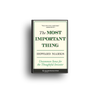Have you misunderstood risk all your life?
Do you use the words, risk, uncertainty and volatility interchangeably as if they were all the same?
Have you lost money, ideas and opportunities because of this misunderstanding?
You're not alone.
An important book helps correct this misunderstanding. Howard Marks, co-founder of Oaktree Capital, distills decades of investing wisdom into about 20 core ideas in a book called The Most Important Thing.
Each chapter begins with “The Most Important Thing Is…” - a deliberate paradox that there’s no single most important thing.
The book is an investor’s manual for thinking, not stock picking.
However, the most important contrarian and counterintuitive clarity that the book provides is about the difference between the three words we otherwise use interchangeably. They are:
Risk v/s Volatility v/s Uncertainty
Risk, Volatility, and Uncertainty are not the same thing.
Mix them up - and you’ll either take on too much, or too little.
When you understand this, you’ll stop making risky decisions and deferring less risky ones just because you incorrectly confused risk with uncertainty or volatility.
Because that's just a stupid thing to do, and you shouldn't do it.
I'd like to explain these three terms in layman's language so there's conceptual clarity, before I get into my learnings from this specific book:

1. Volatility
What it means:
How much something moves - up or down.
It’s a measurement.
Usually standard deviation.
Used by fund managers and the finance industry because it’s easy to quantify.
In real life:
- Your incentive or revenue swings by 10% each month in an otherwise stable market? That’s volatility.
- Stock goes from 100 to 80 and back to 100 frequently? Volatile, but not necessarily risky.
Volatility ≠ danger.
For all practical purposes, it just means movement. It might be annoying, but it’s not fatal.
2. Risk
What it means:
The chance of permanent loss. The stuff you don’t recover from.
It’s real.
Risk is the chance of losing or damaging your capital, your health, your reputation - or your business.
In real life:
- Investing in a business whose industry is in permanent and terminal decline.
- Putting your life's savings into a startup with no margin of safety, market research or industry expertise.
High volatility just feels bad. High risk actually is.
3. Uncertainty
What it means:
You don’t know what’s going to happen. Period.
You can’t even measure it reliably.
Uncertainty = unknown unknowns.
In real life:
- Not knowing when a new pandemic will occur.
- A tech disruption like AI and the effects you can't see coming at the moment.
Uncertainty is always present.
You can’t eliminate it.
You can only prepare for it.
Risk v/s Volatility v/s Uncertainty
| Term | What it actually means | Why people confuse it |
|---|---|---|
| Volatility | The daily, temporary ups and downs in prices and life. | It feels like risk because temporary fluctuations seem like permanent losses. |
| Risk | The chance of losing permanently, what you can’t afford to. | True risk can be invisible, until it’s not and it wipes out or permanently damages what you care about. |
| Uncertainty | Not knowing what will happen next. | It feels like risk because it creates discomfort, anxiety and stress as you can't predict the future. |
How I Like To Think About The Three In Life And The Markets Without Losing My Mind:
Volatility is the cost of staying in the game. Risk is how you get kicked out for life. Uncertainty is basically the nature of the game itself.
So it's best to stop treating all temporary swings in markets or life as risk or danger.
Instead, start asking:
1. Are these just bumps on the road?
If they are, this could just be volatility.
Volatility is the set of ups and downs, twists and turns on the road.
2. Can I recover from this in the long-term?
If I can't, this could be risk.
Risk is a truck speeding towards you on your side of the road while you are sleepy and fatigued.
3. What do I not know?
Am I afraid since I don't know what will happen? If so, this could just be uncertainty.
Uncertainty is not knowing exactly how much time it will take to reach your destination, due to traffic and diversions that you don't know in advance about.
My Key Learnings From The Book:
1. Second-Level Thinking
It’s not what you think. It’s how you think, and in how many levels you think.
- First-level thinkers see things at face value.
- Second-level thinkers ask: What is already priced in? What is the consensus missing?
- Investing is a zero-sum game - outperformance requires thinking differently and being right.
2. Understanding Value
You can’t predict, but you can prepare.
- The foundation of investing is buying assets for less than their intrinsic value.
- Know the difference between price and value - they aren’t always the same.
- Markets can misprice assets due to emotions and herd behaviour.
3. Market Efficiency and Its Limits
The inefficiencies of others can create more wealth for you than the efficiencies of your own.
- Markets are usually efficient - but not always.
- Active investing works only when inefficiencies exist - and you can exploit them better than others.
4. The Importance of Price
No asset is so good that it can’t become a bad investment if bought at too high a price.
- The return you get depends not just on the asset but on the price you pay.
- Value investing means being price-sensitive, not just quality-focused.
5. Risk is Not Volatility
Risk means more things can happen than will happen.
- Risk is not captured by volatility alone.
- True risk is the permanent loss of capital.
- Focus on risk-adjusted returns, not just returns.
6. Recognising and Controlling Risk
Perceiving risk correctly is the first step to avoiding or minimising it.
- Great investors aren’t the ones who just make money - they’re the ones who lose less when others get wiped out.
- Risk control is invisible when it works - and painfully visible when it doesn’t.
7. Cycles Matter
Nothing goes in a straight line forever.
- Economic and market cycles oscillate - between greed and fear, boom and bust.
- Successful investing is often about positioning yourself relative to the cycle.
8. Contrarianism
The consensus is often right - but when it’s wrong, it’s spectacularly wrong.
- To beat the market, you must diverge from the crowd - and be right.
- Contrarian doesn’t mean doing the opposite always—it just means thinking independently.
9. Patience, Not Prediction
It's better to wait, than to predict.
- Marks doesn’t believe in forecasting.
- He believes in being prepared, keeping dry powder, and acting when opportunity knocks.
10. The Role of Emotion
Greed and fear are the enemies of superior investing.
- Successful investing is as much temperament as it is intelligence.
- Train your emotions: don’t overreact to good news or bad.
11. The Margin of Safety
It’s about avoiding loss, not just making gains.
- Always invest with a buffer - between what you pay and what it’s worth.
- The future is uncertain. Margin of safety is insurance against the unknown.
12. Avoiding the Worst Mistakes
You don’t have to be brilliant. Just don’t be stupid.
- Superior investing is not about making brilliant decisions - it’s about avoiding catastrophic ones.
13. Humility and Uncertainty
Intellectual humility trumps intelligence.
- Accept that you don’t know everything.
- Embrace uncertainty. Build portfolios that can survive multiple futures.
14. Skill vs Luck
Skill is what remains when luck runs out, or never shows up.
- Results can be deceiving.
- Success may come from skill, luck, or both - don’t mistake luck for brilliance.
15. The Paradox of Risk
The riskiest time to invest is when everyone thinks there is no risk.
- The perception of low risk is often when risk is highest.
- Always challenge the comfort of consensus.
Who Should Read This Book?
Samridh's Library recommends this book for:
- Investors who want to learn how to think, not what to buy.
- Students of behavioural finance and decision theory.
- Anyone who values humility, risk-awareness, and patience in investing.
Samridh’s Library Checklist of Habits from The Most Important Thing by Howard Marks
Great investing requires thoughtful habits, not heroic moves.
A. Thinking Habits
- Practice Second-Level Thinking
- Every day, ask: “What’s the consensus - and what might they be missing?”
- Before acting, write down: “What happens next? And then?”
- Separate Price from Value
- Habit: Look at any investment or product and ask:
- “What’s the price?”
- “What’s the intrinsic value?”
- “What’s the gap between them?”
- Habit: Look at any investment or product and ask:
- Ask “What If I’m Wrong?”
- Before every decision, run a “what could go wrong?” scan.
- Build in room for error - a margin of safety.
- Use Probabilistic Thinking
- Think in terms of likelihoods, not certainties.
- Write down your expectations in % terms, not binary (yes/no).
B. Risk Habits
- Define Risk as Loss, Not Volatility
- Shift your mindset:
- Not: “How bumpy is it?”
- But: “Can I lose capital permanently?”
- Shift your mindset:
- Control Risk Before It Shows
- Build plans that look conservative in good times.
- Risk control isn’t visible when it works - track it manually.
- Respect Cycles
- Every week or month, ask:
- “Where are we in the cycle?”
- “Is the crowd greedy or fearful?”
- Position accordingly - lean against extremes.
- Every week or month, ask:
C. Behavioural Habits
- Resist Greed and Fear
- Keep a “mood tracker” with your investments.
- If you're euphoric or panicked, pause.
- Be Contrarian - but Thoughtfully
- Don’t just oppose the crowd - understand it first.
- Ask: “Why is the crowd doing this, and what are they missing?”
- Be Humble in Uncertainty
- Build portfolios and life decisions that can survive being wrong.
- Never assume you’ve figured it out.
D. Safety Habits
- Always Seek a Margin of Safety
- Buy or decide only when you have room for error.
- The more uncertain the future, the bigger your buffer should be.
- Focus on Avoiding Big Mistakes
- Avoid heroics.
- Weekly habit: List your 1-2 biggest potential errors - and plan to defend against them.
- Prioritise Survival Over Brilliance
- Build financial and emotional portfolios that let you stay in the game.
- Outlasting > outperforming.
E. Decision Habits
- Don’t Predict. Prepare.
- Write “I don’t know” more often in your notes.
- Prepare for a range of outcomes, not a precise one.
- Respect Luck and Skill
- When something works, ask: “Was I right - or just lucky?”
- Build feedback loops to improve your process, not just outcomes.
Final Thought:
Volatility is the cost of staying in the game. Risk is how you get kicked out for life. Uncertainty is basically the nature of the game itself.
Understand the difference for free (before life and the market teach it to you for a price).
Listen to The Samridh's Library Podcast
Want to be notified when new ideas are released? Follow The Samridh's Library Podcast on ᯤ Spotify or Apple Podcasts to be notified automatically when a new episode is up.



